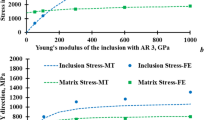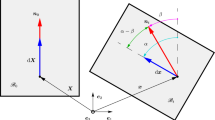Abstract
To construct constitutive equations for hyperelastic materials, one increasingly often proposes new strain measures, which result in significant simplifications and error reduction in experimental data processing. One such strain measure is based on the upper triangular (QR) decomposition of the deformation gradient. We describe a finite element method for solving nonlinear elasticity problems in the framework of finite strains for the case in which the constitutive equations are written with the use of the QR-decomposition of the deformation gradient. The method permits developing an efficient, easy-to-implement tool for modeling the stress–strain state of any hyperelastic material.
Similar content being viewed by others
References
Lur’e, A.I., Nelineinaya teoriya uprugosti (Nonlinear Theory of Elasticity), Moscow: Nauka, 1980.
Ciarlet, P.G., Mathematical Elasticity, Amsterdam: Elsevier, 1988. Translated under the title Matematicheskaya teoriya uprugosti (Mathematical Theory of Elasticity), Moscow: Mir, 1992.
Criscione, J.C., Rivlin’s representation formula is ill-conceived for the determination of response functions via biaxial testing, in The Rational Spirit in Modern Continuum Mechanics, 2004, pp. 197–215.
Criscione, J.C., Humphrey, J.D., Douglas, A.S., and Hunter, W.C., An invariant basis for natural strain which yields orthogonal stress response terms in isotropic hyperelasticity, J. Mech. Phys. Solids, 2000, vol. 48, no. 12, pp. 2445–2465.
Kotiya, A.A., Mechanical Characterization and Structural Analysis of Normal and Remodeled Cardiovascular Soft Tissue, Doct. dissertation, Texas A&M University, 2008.
Srinivasa, A.R., On the use of the upper triangular (or QR) decomposition for developing constitutive equations for Green-elastic materials, Int. J. Eng. Sci., 2012, vol. 60, pp. 1–12.
Freed, A.D. and Srinivasa, A.R., Logarithmic strain and its material derivative for a QR decomposition of the deformation gradient, Acta Mech., 2015, vol. 226, no. 8, pp. 2645–2670.
Delingette, H., Triangular springs for modeling nonlinear membranes, IEEE Trans. Vis. Comput. Graph., 2008, vol. 14, no. 2, pp. 329–341.
Vasilevskii, Yu.V., Salamatova, V.Yu., and Lozovskii, A.V., Concise formulas for strain analysis of soft biological tissues, Differ. Equations, 2017, vol. 53, no. 7, pp. 908–915.
Tyrtyshnikov, E.E., Matrichnyi analiz i lineinaya algebra (Matrix Analysis and Linear Algebra), Moscow: Gos. Izd. Fiz. Mat. Lit., 2007.
Love, A.E.H., A Treatise on the Mathematical Theory of Elasticity, Cambridge: Cambridge Univ., 1920. Translated under the title Matematicheskaya teoriya uprugosti, Moscow: ONTI, 1935.
Kelley, C.T., Iterative Methods for Linear and Nonlinear Equations, Philadelphia: SIAM, 1995.
Knoll, D.A. and Keyes, D.E., Jacobian-free Newton–Krylov methods: a survey of approaches and applications, J. Comput. Phys., 2004, vol. 193, no. 2, pp. 357–397.
Horgan, C.O. and Saccomandi, G., A description of arterial wall mechanics using limiting chain extensibility constitutive models, Biomech. Model. Mechanobiol., 2003, vol. 1, no. 4, pp. 251–266.
Author information
Authors and Affiliations
Corresponding author
Additional information
Original Russian Text © V.Yu. Salamatova, Yu.V. Vassilevski, L. Wang, 2018, published in Differentsial’nye Uravneniya, 2018, Vol. 54, No. 7, pp. 988–995.
Rights and permissions
About this article
Cite this article
Salamatova, V.Y., Vassilevski, Y.V. & Wang, L. Finite Element Models of Hyperelastic Materials Based on a New Strain Measure. Diff Equat 54, 971–978 (2018). https://doi.org/10.1134/S0012266118070145
Received:
Published:
Issue Date:
DOI: https://doi.org/10.1134/S0012266118070145




